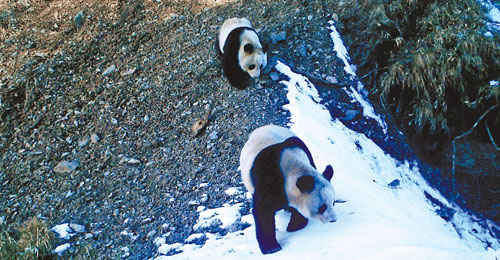Panda 'love corridor' under threat
Updated: 2015-04-13 07:33
By Huang Zhiling in Chengdu and Peng Yining in Beijing(China Daily)
|
|||||||||||
|
A panda and her cub wander at the Anzihe Nature Reserve in Sichuan province in 2012. The reserve is a passageway used by wild pandas to travel between two habitats and find partners during mating season. Provided to China Daily |
Hikers are disrupting the animals' movement along a vital passageway between nature reserves. Huang Zhiling in Chengdu and Peng Yining in Beijing report.
Wildlife watchers and hikers are posing a risk to a vital passageway used by giant pandas in China's southwest to find partners during mating season, conservationists have warned.
Dubbed "the love corridor" by park rangers, the forests of Anzihe Nature Reserve in Sichuan province link two major habitats for the endangered animals.
However, an increasing number of tourists sneaking into the area, which is closed to the public, mean the wild pandas are being scared away from the route, putting further strain on efforts to get the animals to reproduce.
"We're seeing more people and less pandas," said ranger Fu Qiang, who has worked at the reserve for six years. He warned: "The corridor might be blocked if people continue to stream in."
Anzihe, which is in the northwest corner of Chongzhou city, was set up in 1993 and is a major panda habitat. More importantly, it is a link between the world-famous Wolong National Nature Reserve, in Wenchuan county, and Dayi county's Heishuihe Nature Reserve, and is used as a passageway by male and female pandas in mating season.
Cameras to monitor the animals' movements are strategically placed among the trees, and Fu said it is not uncommon for them to capture touching scenes such as those released by the park in 2013, when footage showed a female panda and her frolicking cub navigating a steep slope.
Yet the 34-year-old ranger said it was now more common for the cameras to record tourists wandering the forests.
During a patrol on one icy morning in February, he and his colleagues encountered a group of six hikers. "Anzihe is very close to a public forest park, and there is no fence between," he said. "I told the hikers not to go any further into the reserve, and pointed out that the boundary tablet was right beside them."
Later that same day, his team came across a group of 20 people, all with hiking canes and climbing equipment.
"One man pushed me. The path is only 1 meter wide, and I almost fell down the slope," Fu said. "They all got through. We couldn't stop them. One of them said they just wanted a hike in the reserve and wouldn't cause any harm. But they don't realize that their hike has a negative influence on the pandas and other wild animals."
That was just one of many conflicts Fu had with tourists, and the frequency is growing.
In turn, park rangers have noticed a reduction in the traces of wild panda activity on the reserve's border. Evidence suggests most of the animals have retreated to the core area to avoid invading sightseers.
Today's Top News
Failed developer shoots dead 3, injuries 2 in Milan
Creating climate change solutions through entrepreneurship
Tremendous opportunities created for Dutch businesses in China
Belgium's mixed signals to China
Putin backs China's Silk Road proposal
Boston bomber convicted, may face death penalty
Zhou trial likely to serve as model
Belarus to expand trade and economic ties with China
Hot Topics
Lunar probe , China growth forecasts, Emission rules get tougher, China seen through 'colored lens', International board,
Editor's Picks

|

|

|

|

|

|







